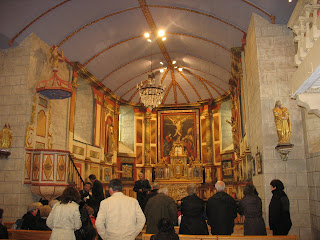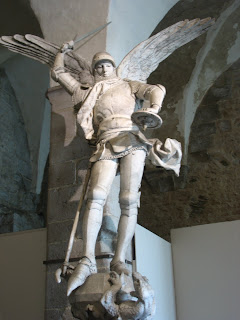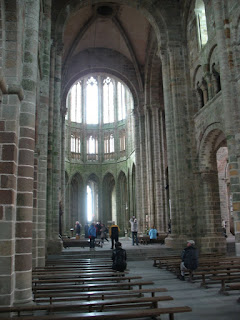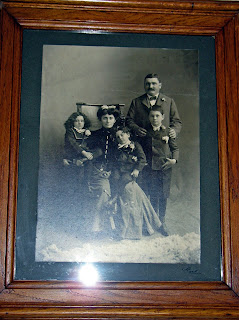
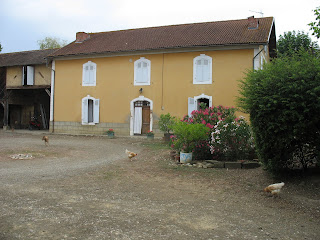
The road from the back of the house in Moumoulous begins with a section that is capped with asphalt. This lasts only about 200 yards then it turns into packed gravel, another ½ mile or so then it becomes just two well worn tracks through the grass. At the beginning the corn is over 6 feet high on both sides so it is like walking through a corn maze. As we walk further up the hill there are open fields of grass with grazing cattle. The French in this area raise cattle called Limosin they are a very pale almost white color. We are surprised that there are no real fences. There are small stakes or posts in the ground with a single strand of electric fence wire.
“Do not touch ze wire!” says Jean Mark.
The current in France is 220 amps vs. 110 in the US. I think that means you will get twice the heart stopping shock if you get involved with the fence. To hold back a 1500 pound cow or 2000 pound bull it takes a lot of electricity. The cattle seem to know this and never challenge the wire. They just walk around and graze look up once in a while then graze some more.
The road comes to a Y.
“We walk through ze woods” says John Mark.
We continue up hill and walk into a densely covered area with acacia, poplars and some oaks trees, ferns and vines and many varieties I don’t recognize. I squint into the shadows looking for the ROUSE and the fire pits.
“This is our forest” he states. Then he tells us that land owners in this area own an undivided interest in all of the forests.
“We are now very near to Montegut” he tells us.
We have reached a high point in the trail and there is a break between the trees. We step out onto the grass and are instantly engaged in the panoramic view of this tiny valley. On the down slope there is a large pond surrounded by tall grass.
“It is there” Jean Mark says softly and points.
Just beyond the pond we see the red tiled roof of Montegut. The wall that faces us is that of the barn side of the L-shaped structure. At the north corner of the building there is a enormous weeping willow tree then a row of three elms, lush with foliage The barn is constructed of many rows of large river rocks. Just to the right there is a white metal gate attached to two square posts, capped with red brick pyramids, then a concrete wall that runs about another 50 feet to the south. From our vantage point we can see that there is another large building, (we learn later it is a garage built of adobe in 1870 to house large farm equipment – think Threshing machine), and a garden area and orchard nearly twice the size of the house and barn area.
Everywhere we look it is green, every shade of green I have ever seen.
Several minutes pass in silence. We stare at Montegut, it is real and we are finally here. It is difficult to move, we are all mesmerized by the moment.
We slowly make our way down the grassy hillside and come to a small vineyard next to the pond.
“These are Joseph’s grapes, what ever you do… do not drink his wine” warns Jean Mark.
We walk further down the hill and onto the road next to the house. Barry reaches out and puts his hand on the corner of the building, and then gives it several affectionate pats - it is far too large to hug. Then we enter Montegut on foot, just as Octave left.
There is a large gravel courtyard. Once in a while a chicken will dash across from the barn to the trees or off to the orchard. Man, this is an old house, really old. The front doors open and Joseph and Terese step out, they must be at least 100 years old. These are two tiny people frozen in time. They speak not one word of English and are yelling out something in French. It sounds welcoming. They take a few steps out of the doorway and open their arms. There is a frenzy of cheek kissing everybody gets kissed on both cheeks. We are invited in to the house. Joseph has a bottle of wine on the table with glasses. The bottle has been opened, but we are not sure if this is the wine we were warned not to drink. Jean Mark asks Joseph if this is his wine and he answers in the affirmative. Then Jean Mark goes a little further and asks him something in French. There is a brief reply then Jean Mark laughs. He tells us that it is okay to drink because it is purchased wine not homemade. Joseph told him that this was his wine because he bought it.
We are taken on a tour of the house. At the top of the stairs, with much pomp, the double doors are opened and we enter the room where Octave, his father and grandfather, and several more were born. In the grandparents room… also frozen in time… there on the wall are two framed portraits. One is a picture of Barry’s grandfather Octave his wife Victorine and 3 children, Frank, Ernest and Henry. This is a professional picture staged and with the family dressed in their finest perhaps taken to commemorate the turn of the century. The picture was taken long before the birth of Octavia, Barry’s mother, in 1907. It has been hanging on this wall for 100+ years. This picture was sent to the family from America by Octave and was among the last correspondences received. There is another portrait, Octave’s niece Francine as a young girl, she was the last of the Dargeles line to live in the house.
We are told that this family has held tight and passed along the story of the two Dargeles brothers who left for America and never returned. In the family it is said that Montegut has slept since they left, but now that the Dargeles family from America has returned it is again awake!


